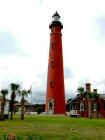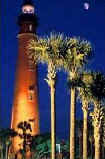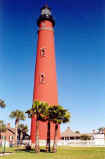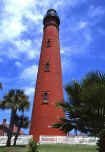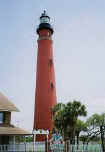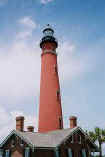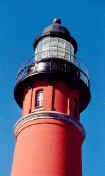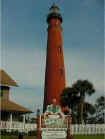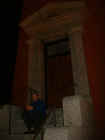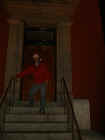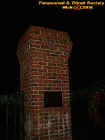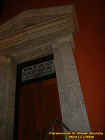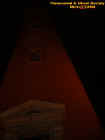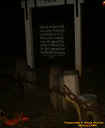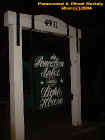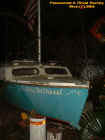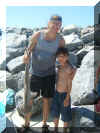|
|
||
|
Often when you hear of a lighthouse you hear tales of shipwrecks, pirates, and tales of sea monsters. The reason for my investigation of the lighthouse is that there is an enormous amount of strange history surrounding it just like with any landmark this one has history told dating back to 500 years ago. But what captivated me more to investigate this place was the first time I visited it when I moved down here it was one of the first places I visited. I remember taking my family to a nearby fisherman's wharf to have the catch of the day and upon touring it I was just amazed at all the shark tales and photos I viewed here. After my evening of visiting the lighthouse and eating a delicious seafood dinner I was determined to do research on the Ponce DeLeon Inlet Lighthouse and the surrounding area. Before I go into the history on the lighthouse first let me say this if you ever have a chance to visit Florida or a lighthouse this would be the one worth making the trip for. The lighthouse is a public historical landmark and 200,000 visit it yearly they strictly run on donations and tours. I was very disheartened by how rude the program director was towards our organization pertaining to the lighthouse. The director told us that we are not allowed to write about the lighthouse, talk about it to our members, take photos etc etc and made it clear what we do is not educational despite the fact that previously they have allowed other paranormal groups to check out the lighthouse we were treated with discrimination. We were not only denied a tour but I was told as well that I was not allowed to visit it because of the type of work that I do. Despite the books and many websites about the lighthouse we were denied its history and insulted. This person should be terminated and have a complaint filed on them. You would think the lighthouse staff would want its history shared so that others could visit it and donate as well as take there tours so really this is benefiting them. So we ask that you take into consideration how hard we had to work at not only the investigation here but the research as well as courage. Despite the rudeness we have faced it is my duty as the founder to provide our members and the public with factual and truthful data not only on the history but the ghost that surround it no matter what the program director says. Therefore with perseverance I bring you the second tallest lighthouse in the state of Florida and my plea that according to the US constitution and my freedom as an American Citizen rightfully I am bringing you an unforgettable story of the sea, pirates, tragedy, history, ghost tales in what has shaped to be one of our greatest investigations in Florida so far. As promised I bring to you Ponce Deleon's Inlet Lighthouse. In 1513 a man came by ship known as Juan Ponce DeLeon to an inlet which sat at the mouth of the Halifax River and The Atlantic Ocean. The inlet also had a peninsula which today we call this land Ponce Inlet. Perhaps there is a haunting feeling sailing a vessel past this area as the peninsula is more like a lush jungle with very heavy foliage. When we read history about the inlet there are tales of some of the first English Pirates visiting these waters. Although the Spanish did discover the inlet they did not establish a colony here however eventually they would control this area in 1784. In 1569 another explorer by the name Captain Antonio de Prado' explored the inlet once again. He Christened The Mosquitoes because so many surrounded him at the inlet. During the 1500s was a tragic time for explorers since at that given time there was no lighthouses and the area was very unexplored. There is an island called disappearing island which only appears in low tide in the inlet this perhaps could cause ships to get caught up or even cause them to sink. At the time many other explorers in the area dared to venture into the inlet an example of this is French Admiral Jean Rebault's Entire French Fleet. Tales of this were told as rumor has it they were inside the inlet when a hurricane came through. These ships did sink and there is very little doubt that the men did not die as waters were very rough. Then in 1585 the famous Spanish Galleon The Flota of General Francisco de Noboa sank. Today at some of the local wharfs surrounding the inlet is talk that many silver and gold coins were being found on the inlets deep bottom. Then came the early 1800s and at that time there were many plantations in the area most of them we have investigated or written about in previous investigations. Ship building around the inlet was very popular as the area was full of live oak and lumber. This created the legend of old ironsides. Shipping became very large as fresh supplies could be brought in or shipped out to other locations produced from the plantations. Keep in mind that this area played a big role at the time because railroading was nonexistent. In 1821 the Spanish passed the land back on to the United Stated. Congress then approved to have a permanent beacon and lighthouse to be constructed. So in Mosquito Inlet in 1934 congress had given $11,000 to building such a structure. In 1934 a 45' tower was built which had 15 oil lamps. The tower was made out of bricks. By 1935 only a year later the lighthouse was complete the only problem was is that the oil for the lamps was never provided so it remained dormant. In 1835 a hurricane did hit the inlet it leveled the lighthouse keepers quarters and damaged the foundation which supported the lighthouse. This was the same year the Second Seminole War broke out. The first lighthouse keeper who spent over a year here named William H. Williams decided it was time to move his family away with the fact there was no oil to light the beacon and Seminole tensions he abandoned it. Weeks later some Seminoles broke into the tower up to the beacon room shattering glass and confiscating the reflectors which they used in there head dresses. The Indians responsible for the burning of the plantations also started the lighthouse on fire by the names of King Philip and his son Coacoochee (Wildcat) a father and son. The lighthouse in 1836 eventually had fallen into the sea. During that time the Seminoles responsible for the burning off the plantations were caught at the Mosquito inlet and taken prisoner by the Mosquito Roarers. But at that point it was to late the Peninsula and Lighthouse remained abandoned for the next 50 years. In March 1883 a small amount of acreage was purchased by a man named Francis Hopkinson Smith which was a writer and engineer. He also was the designer of the new lighthouse. The Chief Engineer of this project Orville E. Babcock also was working on the project till he drowned in the inlet which halted its construction. It took four years to complete the tower and was lighted in 1887 by the keeper William Rowlinski with a fresnel lens made in Parish 1867. The light was said to be visible as far as 20 miles out to sea. This was the only light visible from the St Augustine & Cape Canaveral Seashore. The light also illuminated up to 60 miles of shoreline. The lighthouse stood at 175' in height making it the second tallest in the nation and the tallest in the state of Florida. Lighthouse historical facts state that over 1.4 million bricks were used, the base is452' wide where the bottom brick walls are 8' thick and has a 32' diameter across on the bottom. The very top where the beacon light is it tapers 13' and the walls are 2' thick. The semi circular steps roughly 213 steps if you include the ones outside leading up to the beacon. There is another 10 steps which lead to the lens room. In 1897 another tragedy struck near the inlet the sinking of the S.S. Commodore which sank in a storm. It was one of the first steam tub boats built for harbor work. The tugboat was famous for attempting to run guns to Cuba. During the storm every member was killed on the crew accept one his name was Stephen Crane which was a New York Times Reporter. He ended up adrift a small raft for 3 days and told a tale of how the lighthouse guided him to shore at night. His most famous novel The Red Badge Of Courage a Civil War Classic is what rings a bell with most who have read his material. After this tragedy he did write a short story called The Open Boat which would commemorate the S.S. Commodore and his experience. In 1909 the Kerosene Lamp was replaced by an incandescent oil vapor lamp then by 1933 a 500 watt electric lamp was installed. What was a first order fixed lens was replaced with a third order revolving flashing lens. Just a few years before generators were installed to light the three keepers home on the lighthouse property. Also around that time what was called Mosquito Inlet was now renamed to The Ponce DeLeon Inlet to draw in more people interested in real estate. That way people could buy property on the land surrounding the lighthouse and establish some residency here. It later become a small city with some eateries, cottages, shops, boat yards and of course the establishment of lighthouse park. Since an Electric lamp was installed there was no longer a use for two assistant lighthouse keepers. In 1839 the US coastguard took over the lighthouse and the keeper moved out. They used this as a guard station to watch for German Submarines that would sneak up near the Florida coast. By 1953 there was no longer a need for a keeper although Coast Guard owned the lighthouse was now automated. Then in 1970 they abandoned the lighthouse because the Coast Guard installed a new beacon just south of the inlet in New Smyrna. This mammoth tower now became abandoned all the way till 1982 where it was restored and deeded over to the Town Of Ponce Inlet. It is one of the very few lighthouse stations to have all of its original buildings still standing from the times when a blue uniformed lighthouse keeper would climb to the top check his oil supply or clean his lens. Ponce DeLeon Inlet Lighthouse Preservation Association, Inc was in charge of the project and is a non profit organization which helped preserve the lighthouse today. They also restored the new modern VBR-25 optic light which is still in use today and perhaps is one of the brightest of lighthouse lights that are used in these sea fearing structures. It is hard to believe that almost a second time this lighthouse almost became in ruin. It is now designated as a National Historical Landmark. What has become of the inlet today well lets see there is about 3000 residents living here on the peninsula for one. Two there is a few very good sea food restaurants which all there fish is caught right in the inlet everyday. There are a few ships sunken in the inlet which have created reefs. So many sharks have been pulled out of the inlet for the last 50 years and still today many variety of fish are still caught. The three keeper's dwellings are now museums for tourist such as the lighthouse museum, sea museum and period house museum. Blue prints taken from lighthouse architect 1883 of an entrance building were constructed in 1992. They would use this as a gift shop, restrooms, meeting room, and research library. The boatyard which is behind the lighthouse displays historic vessels. Currently we investigated the 46' FD Russel Tug Boat which was very well known to the area in 1938. The wood vessel was built by the St. Mary's River by Captain Frank D Russel which in high school he had a project to build a ship's wheel. The vessels stern is made from live oak which was cut down fresh in the Turnbull Hammock and the deck was made out of cypress. The principal keepers dwelling housed the keeper and his family for many years they of course use it as a Sea Museum. There is ship models here, treasures of pirates, marine biology, navigational instruments etc. There is a lens work shop in the keepers bedroom where others can learn about the historical lenses used in the lighthouse as well as lighthouse artifacts. Another building on site is a Woodshed which was used to store wood for the fireplaces and the stove of the Second Assistant Keeper's family was stored here. Near here was also an outhouse for the assistant keeper to use. Now this woodshed is now used as a video theater which talks about the history and life of being a keeper when it was called Mosquito Inlet Lighthouse Station. Another building on site called The Pump House served as a well this was erected in 1907 and housed a water pump which would operate the on site windmill. Since 600 gallons were pumped into the towers water tank it create electricity which was used to generate power to the station and power the generators. I heard from doing my research that the windmill was taken down since over the years an electrical water pump was installed. Then if you walk further on site there is a 600lb bronze bell and was cast by E.A. Williams Bell of NJ in 1911. The bell was designed to be used at a lighthouse station to signal ships during fog. Instead the used the bell on a sea buoy at the entrance to the Charleston Harbor SC also a very old city and during a storm it was sunk. The coast guard in 1987 recovered it and donated it to the lighthouse. Lee and I passed by the bell it truly is amazing. Then we have the First Assistant Keeper's Dwelling named after Gladys Meyer Davis a resident born in Ponce Inlet. Her father Edward was the last Principal lighthouse keeper for this lighthouse. This building is also restored with all the old furniture from the 1800s from the Meyer family including a china cabinet from 1887. There also is a laundry wash shed behind it where clothes could be cleaned. The second assistant lighthouse keepers dwelling has also been restored but at one time it served for the keepers family and an assistant at the station. When there was no need for a second assistant it was used as a Town Hall for the town of Ponce Inlet. If you were to visit it today it features early keeper uniforms, documents, history of the lighthouse and the inlet. Also there is many charts and artifacts from the earlier days when the lighthouse was in operation. in 1995 a new structure was built on site called the Ayres Davies Lens Exhibit Building. This building houses a collection of lighthouse lenses and explains how the lenses functions and were used in the lighthouses. It also displays the First Order Fresnel Lens which was used in the Cape Canaveral Lighthouse and the third order lens used in the Ponce Inlet Lighthouse before it was modernized. Even though the building was new it was designed to look like all the others. Also on site is a oil storage house which was built in 1887 same time the lighthouse went into operation. This building made history as it was the first and largest building to store kerosene at any lighthouse. There was shelves inside which could hold 2,500 gallons of mineral oil. Each can could old 5 gallons so imagine walking into this shed seeing 500 cans. In 1927 iron tanks replaces the use of oil cans. In 1970 vandals started this building on fire perhaps they thought it would go boom and it took 19 years for it to finally be revived to its original look. Finally the last building on site is the Generator and Radio building. This was a woodshed and also served as a outhouse for the First Assistant Keeper and his family. It housed 2 generators till about 1940. When the coast guard took over they build the radio shack next to the woodshed which would be used for communications. Today if you were to tour this you would see the keepers tools and photographs from all kinds of lighthouses around the world. So as you can clearly see there is at least 500 years of history involving this lighthouse. With the help of alot of reading I was able to compile such history to share with everybody. But what I have not talked about much here is the lighthouse Hauntings something even the program director has denied and why I do not know since ghost stories about this lighthouse have been told long before this lighthouse was deeded to the town of Ponce Inlet and surely long before she was the program director for it. But lets face it people have died in this inlet in so many different ways whether it was a ship wreck, battle from war, drowning and even in one cast a man died of a heart attack inside the lighthouse when carrying a can of kerosene up the stairs. Since then people claim to smell kerosene in the lighthouse despite it is no longer used especially since 1909. But over the years psychics and even perhaps other paranormal groups have ventured here but very few failed at perhaps finding out the truth and that is what I wanted to do not be selfish but to bring you some real photos of real ghost. Its also said janitors and employees will hear footsteps, doors slamming and actually now and then have a ghost sighting on the property. One of the principal lighthouse keepers son was killed by a horse could it be a ghostly child? I believe that some of the energy here is residual I mean there is 500 years of history on this peninsula especially around the lighthouse park. You have had families live in these buildings on site, people have come and gone, died and lived. Each year so many people visit the lighthouse imagine how many of these peoples energy are put into such a place as so many climb all the way to the top just for a view of the Atlantic Ocean. But its not just the lighthouse that in my opinion is haunted its the whole peninsula of Ponce Inlet besides its strange feelings when driving down its dark roads at night in the woods it was the place I got my first fishing ticket in Florida which later was thrown out. So in closing statements much mystery remains here just approach the front gates at night and try to take a step back into history. Imagine the different emotions that took place here as men would drown on board a vessel or someone was eaten by a shark. Imagine the keeper who had a heart attack and died on the stairwell or how a keeper in a blue uniform would carry just a little lantern and have to walk all the way up to the top of a lighthouse just to keep it lit for lost ships. So much imagination and so much history and now we can bring it to you. I would investigate this lighthouse all over again if I had the chance but we must ask ourselves what other secrets in Ponce Inlet still remain unknown? © By Rick-AngelOfThyNight In accordance with Title 17 U.S.C. Section 107, any copyrighted work in this message is being distributed under fair use without profit or payment to those who have expressed a prior interest in receiving the included information for non-profit research and educational or criticism purposes only. Notwithstanding the provisions of sections 106 and 106A, the fair use of a copyrighted work, including such use by reproduction in copies or phone records or by any other means specified by that section, for purposes such as criticism, comment, news reporting, teaching (including multiple copies for classroom use), scholarship, or research, is not an infringement. Anotherwards a few photos are borrowed we do not make any profit off pictures mainly they are used for historical, criticism, theories and other educational purposes therefore we can use them as long as we do not claim them as our own or get paid for those photos specifically. Dawn Dusk Fishing Expeditions By The Lighthouse Many sharks swim in the water around me and many people swim without knowing this. I always catch nice fish while going up to my chest in the water. But May 13th 2006 I caught a hammerhead which was almost 4 feet and although its not the biggest it swam a few feet away from my legs took my line and put up a nice half hour fight. I also seen a right whale near by and well the photos are below! |
||
|
|
|





